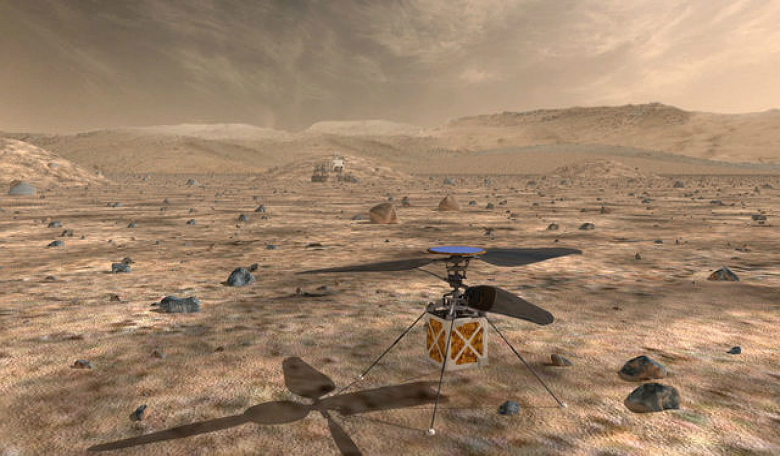What is a mission to Mars without some sort of steadfast but bulky mobile laboratory that ambles over the martian surface looking for clues to help decipher this planet’s past. Rovers such as Curiosity and Opportunity not only have a certain charm about them, they are undoubtedly integral to furthering our knowledge of the Red Planet from a ground level perspective.
But, it has to be said, they are a little on the slow side when it comes to manoeuvring about the rocky terrain and there are some places that they simply can’t go. What would be really handy on the next Mars mission is a small helicopter that could whizz over the surface, taking pictures as it went. We're in luck then, as NASA has built one ready in time for the Mars 2020 mission.
Designed to fly as high as 4.5 metres (15 feet) above the ground, the Mars helicopter – or "Marscopter – weighs just under two kilograms (four pounds) and is the size of a softball. It will propel itself around the planet with two sets of rotor blades – each 1.2 metres (four feet) long, tip-to-tip – that spin at 2,400 rotations per minute; this is around 10 times faster than an Earth-bound helicopter.
Although the helicopter is a departure from the normal craft NASA are used to building, it should perhaps come as no surprise that the agency are adept at building other types of aeronautic machines; it is what the A in NASA stands for after all. It is also literally a duty NASA must undertake according to the 1958 law that established the space agency in the first place, which says that the space agency is charged with solving the problems of flight within the atmosphere. The law however doesn’t stipulate which planet’s atmosphere it relates to though.
“Flying a heavier-than-air vehicle within Mars’ thin atmosphere has never been done before, and we’re excited our aeronautics experts could help with this important space mission” said Susan Gorton, NASA’s manager for the Revolutionary Vertical Lift Technology (RVLT) project.
This first autonomous rotorcraft will serve as a technology demonstrator and if it all goes well, then remotely explored regions of the planet’s surface could be mapped in greater detail than ever before using similar martian helicopters.
However maiden flights on this planet are not without their problems, let alone the untold difficulties facing a small machine flying solo on another world.
For starters, the vehicle must survive brutally bone-chilling nights, fly in Mars’ barely-there atmosphere, and operate essentially on its own since the nearest pilot is millions of miles away on Earth.
Not one to shy away from a challenge, engineers at NASA’s Jet propulsion Laboratory (JPL) in California, set to work over four years ago to come up with a design that can deal with those concerns, and more.
The result is a helicopter that includes solar cells to charge its lithium-ion batteries, and a heating mechanism to keep it warm through the chilly Martian nights. To fly unaided without the help of a pilot, the helicopter has an autonomous capability that will be able to receive and interpret commands from Earth, and then fly the mission on its own.
The first hurdle is to get it to Mars successfully - something NASA is generally good at – and once safely ensconced on the ground, it will be the Mars 2020 rover’s job to take the helicopter to a suitable location ready for its first historic flight.
This foray into the martian skies will be a short vertical climb to 3 meters (10 feet), where it will hover for about 30 seconds. A further full 30-day flight test campaign is scheduled whereby the helicopter will fly at incrementally farther flight distances of up to a few hundred meters, over five flights, while prolonging the duration up to 90 seconds.
The act of flying a helicopter on Mars will be enough to tick all of the necessary boxes required to make this a successful demonstration, however, as an added bonus, the helicopter is also equipped with a small camera nearly identical in capability to the average smart phone so that it can take pictures of the surface below for transmission back to Earth.
“The Mars Helicopter’s initial flight will represent that planet’s version of the Wright Brothers’ achievement at Kitty Hawk and the opening of a new era,” Gorton said. “For those of us whose research revolves around all things related to flight, that would be a remarkable, historic moment.”











